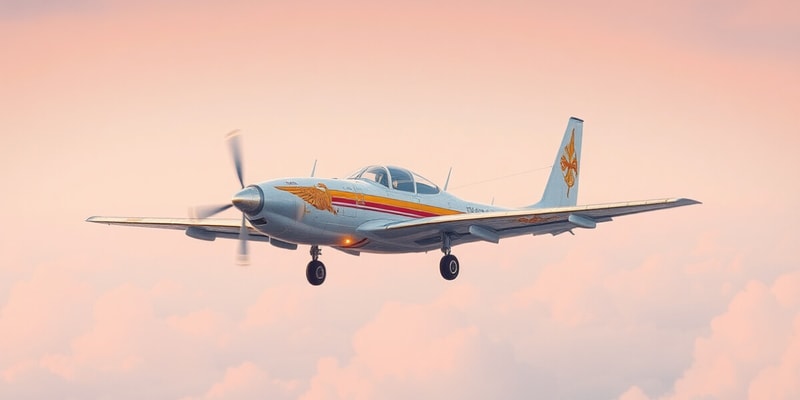Podcast Beta
Questions and Answers
Which of the following values may be used in the assessment of take-off performance?
-
Actual
-
Forecast
-
Reported
-
Expected
For which of the following flights may forecast temperatures (as opposed to actual or reported) be used in assessing performance?
-
Take-off
-
Enroute
-
Landing
Published take-off performance data for aircraft in Performance Group A makes allowance for use of a runway line up distance of:
Given the following data, which is the overall gradient on runway 07?
Elevation at start of rwy 07 is 3050 Elevation at start of rwy 25 is 2830 Legth 2745m.
Signup and view all the answers
Which is true of runway slope in relation to performance calculation for aircraft in Performance Group A?
Signup and view all the answers
For which airplane in Performance Group A is this statement true?
"If an alternate airport is designated in the flight plan, the landing distance required may be that appropriate to an alternate aerodrome when assessing the ability of the airplane to satisfy the requirement of the destination aerodrome."
Signup and view all the answers
For a given declared temperature at which the aircraft performance is being assessed, if it is within a certain temperature of the maximum aircraft operating temperature, the use of declared temperature is not permitted.
Signup and view all the answers
Which is true of the declared distance for a given runway?
Signup and view all the answers
Which is true about TODA?
Signup and view all the answers
Which is true of the declared distance for a given runway?
Signup and view all the answers
Which is true of the declared distance for a given runway?
Signup and view all the answers
Which is the correct procedure in relation to the moment at which an engine failure is recognised?
Signup and view all the answers
Assuming take-off weight, V1/Vr ratio and aerodrome ambient condition remain constant. A decrease in take-off flap setting will cause:
Signup and view all the answers
Minimum control speed (Vmcg) on the ground:
Signup and view all the answers
Which is true of Vmcg on the ground?
Signup and view all the answers
In addition to runway slope and wind component, which one of the following sets of factors affects the brake energy (Vmbe)?
Signup and view all the answers
Regarding improved V2 climb, which statements are correct?
-
Increasing V2 requires an increase in V1 and Vr .
-
Increase in takeoff speeds (V1VrV2) increases TODR .
-
Takeoff climb limit weight is reduced .
-
With an increase in takeoff speed, tyre speed limit and Vmbe may become limiting
Signup and view all the answers
Takeoff decision speed (V1) is the speed:
-
from which a decision to continue the takeoff is made, which results in a takeoff distance to a height of 35ft on a dry runway at a speed of V2, that will not exceed the useable takeoff distance.
-
at which the engine failure is recognised
-
at which the first action is taken to bring the aeroplane to a full stop and will not exceed the ASDA
Signup and view all the answers
When an aeroplane take-off weight is not field length limited, the benefits of selecting a lower V1 are:
-
Improved obstacle clearance
-
Reduced aircraft noise
-
Greater stop margin for a RTO
-
Decrease chance of exceeding Vmb
Signup and view all the answers
Which one of the following is correct in relation to takeoff flight path?
Signup and view all the answers
When an obstacle is to be cleared, on the basis of an extended second segment climb:
Signup and view all the answers
What thrust settings should be used for operating engines in the third segment of the flight path?
Signup and view all the answers
Select the answer which you consider will correctly complete the following statement.
"The net takeoff flight path extends from (i) to 1500' above aerodrome level, and should clear any obstacle in its path by a vertical interval of (ii)"
Signup and view all the answers
The minimum level off pressure altitude, as applied to the clearance of distant obstacles when using the extended second segment climb procedure, may be defined as:
Signup and view all the answers
An obstacle is identified as being 5920m from the end of the take-off distance available, and is 830m from the intended line of flight. Given the wing span of the aircraft is 48m, the semi width of the funnel at a given point is?
Signup and view all the answers
Takeoff WAT curve for an aircraft in Performance Group A assumes:
Signup and view all the answers
At a given take-off weight, aerodrome ambient conditions and characteristics, an increase in take-off flap setting will (i) the second segment climb gradient and (ii) the takeoff distance required.
Signup and view all the answers
Decrease flap from 10° to 5° will result in :
-
Increase in field length limit for a given runway
-
Increase climb limit weight
-
Increase V1 speed for a given weight
Signup and view all the answers
"All other factors remaining constant, a decrease in aerodrome pressure altitude will: (i) the take-off distance required and (ii) the second segment net gradient of climb.
Signup and view all the answers
Using a higher V2 (i) TODR and (ii) distance to an obstacle, resulting in a (iii) climb gradient required.
Signup and view all the answers
Obstacle height is generally referenced to the elevation at the end of the TODA. Assuming the climb gradient is constant, the flight path of an uphill slope runway will begin at a relatively (i) elevation relative to a downhill slope.
Signup and view all the answers
Using a wet V1 on a wet runway, compared to a dry V1 on a dry runway, in the event of an engine failure the safety margin with a continued take-off will:
Signup and view all the answers
Operations involving the use of variable take-off thrust may be conducted:
Signup and view all the answers
Which of the following statements is true concerning operations involving the use of variable take-off thrust?
Signup and view all the answers
Which one of the following statements is true concerning the calculation of the maximum speed for abandoning take-off Vstop on a contaminated runway
Signup and view all the answers
Which is a recommended procedure when operating from a contaminated runway?
Signup and view all the answers
Which of the following statements are true concerning operation on a contaminated runway?
Signup and view all the answers
Which of the following is correct concerning weight and performance provisions/regulations during the enroute phase of flight involving an engine failure?
Signup and view all the answers
In the case of engine failure, the aeroplane must be capable of clearing all objects on either side of the intended track within:
-
10nm
-
5nm providing the operator takes into account navigational aide enroute
-
20nm in mountainous areas
Signup and view all the answers
Landing distance correction factor for (i) forecast headwind component (ii) foreacast tailwind component.
Signup and view all the answers
The landing WAT curve or graph ensures that at a given weight, the aeroplane will have an acceptable minimum climb capability with:
Signup and view all the answers
Study Notes
Take-off Performance Values
-
Values employed:
- Aircraft performance data: This includes information like gross weight, engine performance, and aerodynamic characteristics.
- Environmental factors: Temperature, wind, pressure altitude, and runway condition (e.g., surface friction) all influence take-off performance.
- Pilot technique: Pilot skill and experience directly affect take-off execution, impacting performance.
- Aircraft configuration: Flaps, spoilers, and other control surfaces are adjusted to affect take-off performance.
- Runway length: The available runway length is a key factor in take-off safety calculations.
Inapplicable Value Combinations
-
Incorrect combinations:
- Using values that are incompatible with the aircraft type: This would be using performance data for a different aircraft model.
- Combining values from different sources without proper validation: This could lead to errors if the values are not consistent.
- Using outdated or incorrect information: Outdated performance data or incorrect environmental information will lead to inaccurate assessment results.
Reported Values
-
Reported values fall into the category of:
- Environmental data: This includes METAR (weather) reports, NOTAMs (notices to airmen), and other relevant information.
- Pilots incorporate these values into their take-off planning process.
Valid Values
-
Valid values for take-off performance assessment:
- Aircraft certified performance data: This information is found in the aircraft flight manual and comes directly from the manufacturer.
- Approved performance charts and tables: These are specifically designed for take-off performance analysis.
- Environmental values: These encompass weather, runway conditions, and altitude data.
- Pilot experience and judgment: The pilot's knowledge and experience are essential to effectively assess take-off performance.
True Statement
- True statement: The pilot is ultimately responsible for ensuring that take-off performance is adequate based on the available values and their experience.
Take-off Performance Assessment Values
-
Valid values for take-off performance assessment include:
- Reported values: Data provided by aircraft manufacturers or other reliable sources.
- Expected values: Estimated values based on calculations and assumptions.
- Measured values: Data collected from actual aircraft performance during testing or operation.
- Calculated values: Values derived from mathematical formulas and algorithms.
-
Combination of values NOT applicable: Combining measured values with calculated values is NOT recommended. This is due to the potential for conflicting or inaccurate results.
-
Pilot using Reported Values: When a pilot utilizes reported values, they fall under the Reported values category.
-
Exclusive Use in Take-off Performance Assessment: The values that can be used exclusively in take-off performance assessment are:
- Reported values
- Expected values
-
True Statement: The combination of reported values and expected values offers a comprehensive assessment of take-off performance.
-
Incorrect Statement: Measured values are always considered the most accurate for take-off performance assessment. This statement is incorrect because measured values can be influenced by environmental factors and operational conditions.
-
Unnecessary Expected Values: The use of expected values would be deemed unnecessary when measured values from previous take-off performance tests are available. This allows for a more accurate and reliable assessment based on actual performance.
-
Excluded Values: The combination that excludes potential values for take-off performance assessment is measured values and calculated values.
-
Comprehensive Take-off Performance Assessment: The pair of values that provides the most comprehensive assessment for take-off performance is reported values and expected values. This combination allows for a more reliable and robust assessment, combining theoretical data with actual performance expectations.
Studying That Suits You
Use AI to generate personalized quizzes and flashcards to suit your learning preferences.
Description
Test your knowledge on the various factors that influence an aircraft's take-off performance. Dive into the specifics of aircraft data, environmental influences, pilot techniques, and runway considerations. This quiz also covers the importance of using appropriate value combinations for accurate performance assessments.




